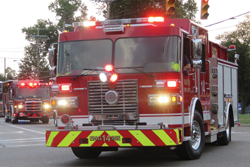Local fire departments see fewer applicants, lose part-time firefighters
by Laura Bednar
A nationwide firefighter shortage has spread from the U.S. Forest Service to community departments. According to a Los Angeles Times article, only 62% of federal firefighter positions were filled in California, an area known for wildfires. The lack of new recruits is also a problem in Richfield Village and Bath Township.
Richfield Fire Chief George Seifert said the department customarily would see 10 applications a year; now it’s closer to two or three. The department has 30 firefighters, 13 full time. Seifert said ideally he would like the number of part-timers to be in the high 20s.
Bath Township Fire Chief Robert Campbell said his department has 34 firefighters, including 21 part-timers. “Two years ago I had over 40 part time,” he said, adding that the department hasn’t had volunteers in years.
Richfield formerly had 30-40 volunteer firemen but currently has none.
“Times change and people get busy,” Seifert said. “There’s not much dedication to this type of field.”
According to Buckeye Farm News, a Farm Bureau Federation publication, Gov. Mike DeWine announced the formation of an Ohio task force on Volunteer Fire Service this spring to study and make recommendations to improve volunteer fire service in Ohio. The group will examine recruitment, training issues and stability of volunteer fire departments.
Campbell cited possible reasons people aren’t interested in the occupation: Young people in the workforce prefer a more flexible schedule, people don’t want a position in healthcare during the pandemic, and reports of cancer risk in the field keeps applicants away.
“We see things other people don’t see and that shies people away [from the position],” said Seifert.
Richfield lost two full-time employees to higher paying positions and some part-timers to full-time positions elsewhere. In talks with other fire chiefs, Seifert said, “One chief said sniping employees from other departments has become a new fire chief sport.”
Bath lost part-time employees who became overwhelmed with the work. Campbell said many part-time firefighters have full-time jobs elsewhere and between continuing education and overtime in their main department, “they decide something’s gotta give.”
In Richfield, 85%-90% of its part-time firefighters work in another department, according to Seifert.
The increase in overtime has led to mandatory callbacks, according to Campbell. When a shift is open, it is first offered to a part-time employee, then full-time employees. If no one volunteers to take the shift, the full-time employee with the fewest hours logged must return to work.
Bath previously had around six callbacks a year. Now Campbell said he has had as many as eight in one week. Seifert said Richfield firefighters work 24-hour shifts to ensure three to four people are constantly on duty.
Firefighter applicants must earn state fire and paramedic certifications and pass timed physical agility tests. Campbell said his department has adjusted the paramedic certification requirement: If an applicant is in good standing in paramedic school, they can be considered. Bath previously offered financial assistance to its firefighters taking college fire or medic programs. Campbell said there have been discussions about resurrecting this concept.
In the meantime, both departments pitch firefighting to students in universities and trade schools or high-schoolers at Cuyahoga Valley Career Center.
If the numbers don’t improve, Campbell said departments could see a regional assistance model become prevalent.
“We hired two new full-time employees this year,” Campbell said. “It won’t fix the problem, but it will prevent it from getting worse.” ∞

